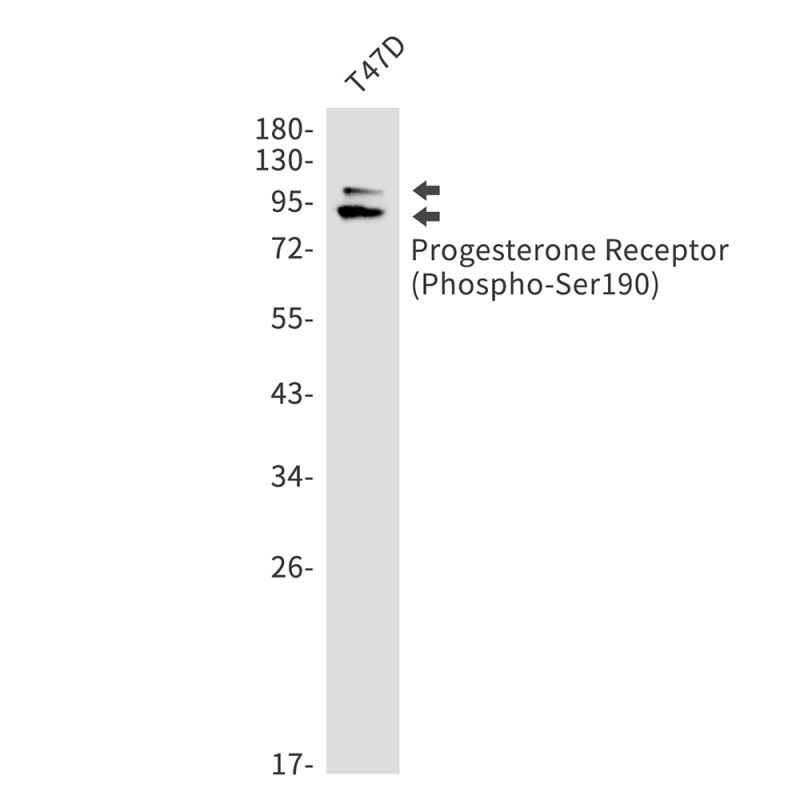
| WB | 咨询技术 | Human,Mouse,Rat |
| IF | 1/20 | Human,Mouse,Rat |
| IHC | 1/50-1/100 | Human,Mouse,Rat |
| ICC | 1/50-1/200 | Human,Mouse,Rat |
| FCM | 咨询技术 | Human,Mouse,Rat |
| Elisa | 咨询技术 | Human,Mouse,Rat |
| Aliases | PGR; NR3C3; Progesterone receptor; PR; Nuclear receptor subfamily 3 group C member 3 |
| Entrez GeneID | 5241 |
| WB Predicted band size | Calculated MW: 99 kDa; Observed MW: 90,118 kDa |
| Host/Isotype | Rabbit IgG |
| Antibody Type | Primary antibody |
| Storage | Store at 4°C short term. Aliquot and store at -20°C long term. Avoid freeze/thaw cycles. |
| Species Reactivity | Human |
| Immunogen | A synthetic phosphopeptide corresponding to residues surrounding Ser190 of human Progesterone Receptor |
| Formulation | Purified antibody in TBS with 0.05% sodium azide,0.05%BSA and 50% glycerol. |
+ +
以下是关于Phospho-Progesterone Receptor (Ser190)抗体的3篇参考文献示例:
1. **"Progesterone Receptor Phosphorylation Regulates Stem Cell Expansion in Breast Cancer"**
- **作者**: Daniel AR et al.
- **摘要**: 研究利用Phospho-PR (Ser190)抗体,通过Western blot和免疫荧光分析,揭示了Ser190磷酸化在孕酮受体介导的乳腺癌干细胞增殖中的作用,提示其作为治疗靶点的潜力。
2. **"Ligand-Specific Phosphorylation of Progesterone Receptor at Ser190 Differentially Regulates Gene Expression"**
- **作者**: Hagan CR et al.
- **摘要**: 通过ChIP-seq和报告基因实验,结合Phospho-PR (Ser190)抗体,发现Ser190磷酸化在孕酮和拮抗剂作用下呈现不同模式,影响受体与DNA结合及靶基因转录活性。
3. **"Phosphorylation of Human Progesterone Receptor at Ser190 Activates Nuclear Localization and Promotes Tumor Growth"**
- **作者**: Lange CA et al.
- **摘要**: 使用Phospho-PR (Ser190)抗体验证了磷酸化修饰促进PR核转位及肿瘤生长,通过突变实验证明Ser190位点对受体功能的关键调控作用。
(注:以上文献为示例,实际研究中请根据具体抗体品牌或数据库检索结果调整。)
The Phospho-Progesterone Receptor (Ser190) antibody is a specialized tool used to detect the progesterone receptor (PR) when phosphorylated at serine residue 190. PR, a member of the nuclear receptor superfamily, exists as two isoforms (PRA and PRB) and mediates progesterone’s effects in reproductive tissues, mammary glands, and the central nervous system. Phosphorylation is a key post-translational modification regulating PR activity, influencing ligand binding, nuclear localization, and transcriptional activation. Ser190 phosphorylation, located in the PR’s N-terminal domain, is associated with receptor activation and downstream signaling. Studies suggest this modification enhances PR interaction with co-regulators and promotes target gene expression, impacting processes like cell proliferation, differentiation, and apoptosis.
The antibody is widely used in research to investigate PR signaling dynamics in hormone-responsive cancers, such as breast and endometrial cancers, where dysregulated PR phosphorylation may contribute to disease progression or therapy resistance. It enables detection of phosphorylated PR in techniques like Western blotting, immunohistochemistry, and immunofluorescence, aiding in the study of hormonal regulation, drug responses, and biomarker discovery. Understanding PR phosphorylation at Ser190 provides insights into progesterone signaling mechanisms and potential therapeutic targets, particularly in contexts of endocrine resistance or reproductive disorders. Proper validation, including knockout controls and peptide competition assays, ensures specificity in experimental models.
×